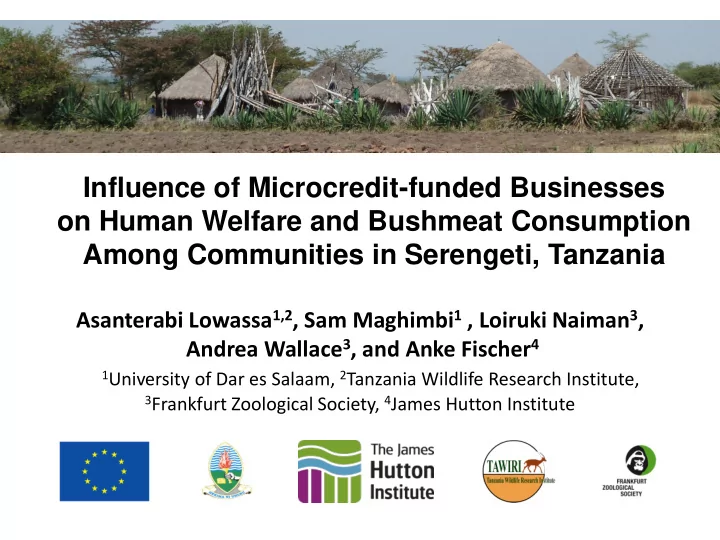

Influence of Microcredit-funded Businesses on Human Welfare and Bushmeat Consumption Among Communities in Serengeti, Tanzania Asanterabi Lowassa 1,2 , Sam Maghimbi 1 , Loiruki Naiman 3 , Andrea Wallace 3 , and Anke Fischer 4 1 University of Dar es Salaam, 2 Tanzania Wildlife Research Institute, 3 Frankfurt Zoological Society, 4 James Hutton Institute
Bushmeat hunting in western Serengeti Hunting seen as poverty-driven activity Efforts to link conservation and development goals Community-based conservation initiatives; Wildlife Management Areas – support of social services Communal benefits often perceived negatively In 2009, FZS and Tanzania National Parks (TANAPA) initiated a microcredit scheme - Community Conservation Bank (COCOBA)
The microcredit concept Launched in 1983: Grameen Bank in Bangladesh – Prof. Yunus earned Nobel Prize in 2006 Aim : To help poor households in accessing capital to improve their income generation initiatives Recently implemented around Serengeti National Park Assumption : will improve livelihoods and therefore reduce pressure on wildlife
Formation of COCOBA groups
COCOBAs – how they work 1,000 – 3,000 TSh per week COCOBA
Study objectives To complement a widespread economic perspective with social perspective To investigate the impact of microcredits on bush meat consumption To investigate the impact of microcredit- funded businesses on perceived wellbeing of a household
Methods Site: Western side of Serengeti National Park (outside Park) Qualitative and quantitative methods • 8 FGDs ( Checklists ) with loan takers and trainers in 4 villages • Questionnaire : Quasi-experiment, comparing households from the same villages who had (n=63) and those that had not (n=58) participated in the microcredit scheme Key variables included were: 1. Amounts of protein consumed: dietary recall exercise 2. Self-reported wellbeing 3. Use of the loan
Results 1.Protein consumption in households with and without microcredits Microcredit takers Non-credit takers Bushmeat Bushmeat Mean: 1.17 meals per week Mean: 2.36 meals per week p<0.05 Non-bushmeat meals Non-bushmeat meals (beef, chicken, fish, goat) (beef, chicken, fish, goat) Mean: 2.80 meals per week Mean: 1.87 meals per week not significant
Results COCOBA and bushmeat consumption – implications Difference in number of bushmeat meals was significant. Microcredit users consumed bushmeat less frequently. Potential explanation: Microcredits supported the purchase or raising of other (more expensive) proteins such as beef, chicken, goat, sheep, fish
Results 2.Credit spending 50% of borrowers 60 used all credit to establish business Credit Percentage 40 45% of all borrowers 20 used credit for meeting household needs (medical 0 costs, school fees) – non-intended
Results The nature of microcredit-funded businesses More people engage in business activities
Results The nature of microcredit-funded businesses Bushmeat trade reduced
Results The nature of microcredit-funded businesses Most businesses are grain & livestock
Results The nature of microcredit-funded businesses Limited capital available & short repayment periods
Results Social structures and business success Gender roles played an important role ‒ Women constrained in their business choice ‒ Significant difference in the frequency of travelling for business (p<0.05) Most women confine business to their home village ‒ This was due to gendered tasks assigned to women
Summary • Microcredits appear to support business alternatives to hunting and selling of bushmeat • Many businesses funded through credits were based on price speculations (grain trade) • Credits used for social purposes improved household welfare-supported school fees, medical care or housing, but complicated loan repayment
Conclusions Microcredit scheme can support households to consume other, non-bushmeat protein and thus potentially reduce bushmeat consumption Opportunities for long-term businesses need to be improved People seem to have many credit needs other then business creation hence social loans need to be improved To support conservation, a strategy is needed to upscale microcredit schemes to other villages adjacent to protected areas
Acknowledgements Supervisors Prof. Maghimbi – University of Dar es Salaam - Dr. Anke Fischer – James Hutton Institute - EU and the CREATE Project – for funding this study Frankfurt Zoological Society – for field assistance Dr. G Wallace and Dr. A Wallace – data management Dr. S Nindi, Dr. S Mduma and Dr. D Rentsch for their support and advice THANK YOU ALL FOR LISTENING
Recommend
More recommend